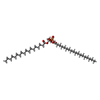+Search query
-Structure paper
| Title | Structure of the human LAT1-4F2hc heteromeric amino acid transporter complex. |
|---|---|
| Journal, issue, pages | Nature, Vol. 568, Issue 7750, Page 127-130, Year 2019 |
| Publish date | Mar 13, 2019 |
 Authors Authors | Renhong Yan / Xin Zhao / Jianlin Lei / Qiang Zhou /  |
| PubMed Abstract | The L-type amino acid transporter 1 (LAT1; also known as SLC7A5) catalyses the cross-membrane flux of large neutral amino acids in a sodium- and pH-independent manner. LAT1, an antiporter of the ...The L-type amino acid transporter 1 (LAT1; also known as SLC7A5) catalyses the cross-membrane flux of large neutral amino acids in a sodium- and pH-independent manner. LAT1, an antiporter of the amino acid-polyamine-organocation superfamily, also catalyses the permeation of thyroid hormones, pharmaceutical drugs, and hormone precursors such as L-3,4-dihydroxyphenylalanine across membranes. Overexpression of LAT1 has been observed in a wide range of tumour cells, and it is thus a potential target for anti-cancer drugs. LAT1 forms a heteromeric amino acid transporter complex with 4F2 cell-surface antigen heavy chain (4F2hc; also known as SLC3A2)-a type II membrane glycoprotein that is essential for the stability of LAT1 and for its localization to the plasma membrane. Despite extensive cell-based characterization of the LAT1-4F2hc complex and structural determination of its homologues in bacteria, the interactions between LAT1 and 4F2hc and the working mechanism of the complex remain largely unknown. Here we report the cryo-electron microscopy structures of human LAT1-4F2hc alone and in complex with the inhibitor 2-amino-2-norbornanecarboxylic acid at resolutions of 3.3 Å and 3.5 Å, respectively. LAT1 exhibits an inward open conformation. Besides a disulfide bond association, LAT1 also interacts extensively with 4F2hc on the extracellular side, within the membrane, and on the intracellular side. Biochemical analysis reveals that 4F2hc is essential for the transport activity of the complex. Together, our characterizations shed light on the architecture of the LAT1-4F2hc complex, and provide insights into its function and the mechanisms through which it might be associated with disease. |
 External links External links |  Nature / Nature /  PubMed:30867591 PubMed:30867591 |
| Methods | EM (single particle) |
| Resolution | 3.3 - 4.0 Å |
| Structure data |  EMDB-0678:  EMDB-0679: |
| Chemicals |  ChemComp-3PH:  ChemComp-AUU: |
| Source |
|
 Keywords Keywords | MEMBRANE PROTEIN / transporter |
 Movie
Movie Controller
Controller Structure viewers
Structure viewers About Yorodumi Papers
About Yorodumi Papers







 homo sapiens (human)
homo sapiens (human)